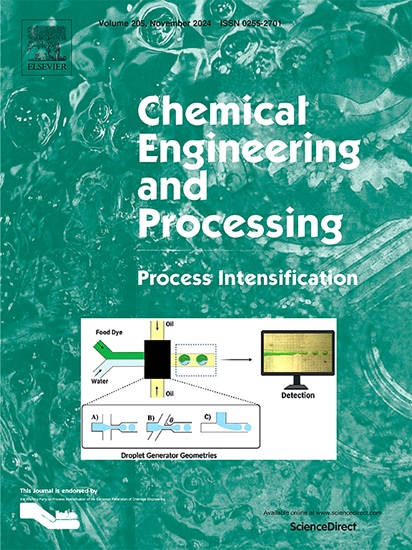用In2S3处理废轮胎活性炭强化废水:可见光活化过硫酸氢盐、表征、组成、pH值影响及机理
IF 3.9
3区 工程技术
Q3 ENERGY & FUELS
Chemical Engineering and Processing - Process Intensification
Pub Date : 2025-05-03
DOI:10.1016/j.cep.2025.110352
引用次数: 0
摘要
In2S3具有优异的光催化性能,包括高载流子迁移率和强光吸收,提高了太阳能转换效率。本研究制备了含20wt .%、30wt .%和40wt .% In2S3的活性炭(AC)衍生光催化剂,考察其与过硫酸氢盐(PDS)降解环丙沙星(CPX)的性能。还评价了pH(2.5-8.5)的影响。采用XRD、FE-SEM、BET、UV-Vis、光电流、PL、ERS和Mott-schottky分析对掺量为30wt .% In2S3的复合材料进行了表征。PDS将CPX的光降解性能从60.8%提高到99.7%。CPX降解的最佳条件为pH = 5.5。此外,清除试验强调了超氧化物(•O2-)、羟基(•OH)、硫酸盐(•SO4毒血症)和电子(e-毒血症)在CPX光降解过程中的显著作用。本文章由计算机程序翻译,如有差异,请以英文原文为准。

Intensified wastewater treatment using In2S3 on activated carbon derived from waste tire: Peroxydisulfate activation via visible-light, characterization, composition, pH influence, and mechanism
In2S3 exhibits exceptional photocatalytic properties, including high charge carrier mobility and strong light absorption, enhancing its efficiency in solar energy conversion. In this study, activated carbon (AC) derived photocatalyst with 20, 30, and 40 wt.% of In2S3 was prepared in order to investigate its performance with peroxydisulfate (PDS) in ciprofloxacin (CPX) degradation. The effect of the pH (2.5–8.5) was also evaluated. The composite with 30 wt.% In2S3 in the presence of PDS showed the best performance, and characterized by XRD, FE-SEM, BET, UV–Vis, Photocurrent, PL, ERS, and Mott-schottky analyses. PDS enhanced the performance of photodegradation of CPX from 60.8% to 99.7%. The optimal conditions for CPX degradation were determined to be at a pH of 5.5. Additionally, scavenging tests highlighted the notable role of superoxide (•O2-), hydroxyl (•OH), sulfate (•SO4⁻), and electrons (e-) in the photodegradation process of CPX.
求助全文
通过发布文献求助,成功后即可免费获取论文全文。
去求助
来源期刊
CiteScore
7.80
自引率
9.30%
发文量
408
审稿时长
49 days
期刊介绍:
Chemical Engineering and Processing: Process Intensification is intended for practicing researchers in industry and academia, working in the field of Process Engineering and related to the subject of Process Intensification.Articles published in the Journal demonstrate how novel discoveries, developments and theories in the field of Process Engineering and in particular Process Intensification may be used for analysis and design of innovative equipment and processing methods with substantially improved sustainability, efficiency and environmental performance.

 求助内容:
求助内容: 应助结果提醒方式:
应助结果提醒方式:


